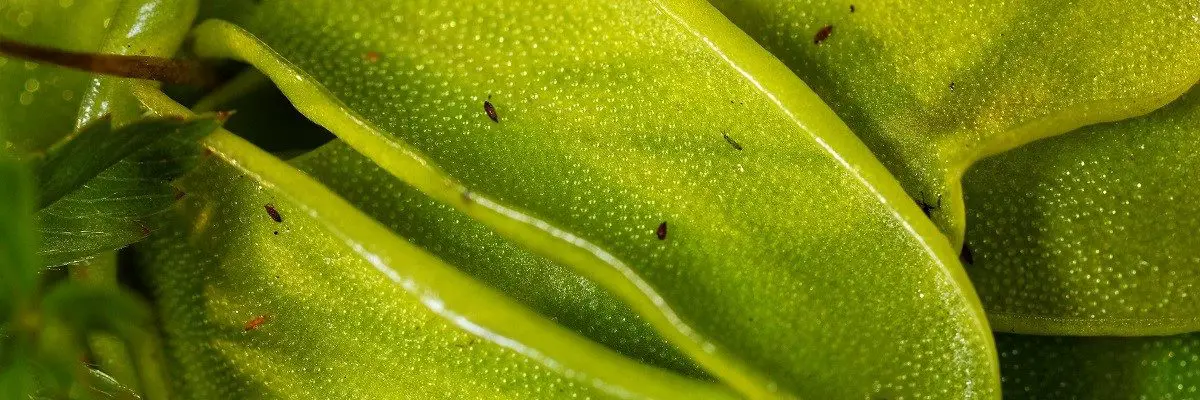Yes, they do. Butterwort is comparable to flypaper in terms of carnivorous plants. This plant, commonly known as “pings,” comes from its broad, green leaves that contain small glandular hairs that secrete a sticky mucus-like substance that feels greasy to the touch. As a result of these drops of mucilage, the leaves tend to glisten in the sunlight, attracting insects.
Diet of the Butterwort (Pinguicula)
Due to the plant’s ability to retain nutrients, the diet will vary based on the taxonomy and size of the prey. Carnivorous plants can access various prey sources depending on their size limitations. It eats several species of arthropods, but most of its prey are insects with wings and the ability to fly. As other plants can become trapped on their leaves, butterworts can also acquire nutrition from pollen and other plant parts that are rich in protein, making them both herbivorous and carnivorous.
In order to capture and digest their prey, butterworts use a mechanism similar to fly paper. The upper surfaces of the leaves are covered with two types of sticky glands. Tall stalked glands attract small insects to their sticky goo. Digestive enzymes are released when unstalked glands on the leaf surface come into contact with nitrogen-rich animal proteins. Over a matter of hours, the leaf edge rolls inward toward the dead animal, helping to aid digestion. The leaf flattens again to await its next victim a few days later.
The microscopic glands allow larger insects to escape, so butterworts’ animal diet consists of smaller insects such as springtails, midges, and aphids. Butterworts are also herbivorous since they can eat pollen and other protein-rich plant parts that get stuck on their leaves.
Since the sticky glands can only be used once and the insect skeletons do not decompose quickly, the leaves’ effectiveness as traps diminishes over the summer. Intriguingly, butterworts interact with insects not just as potential food sources. Bees pollinate the flowers, which are attractive and showy. Therefore, the number of insects captured by these plants decreases as the growing season progresses.
Where is Butterwort (Pinguicula) found?
The dwarf butterwort, found from North Carolina south to Florida and Texas, is much smaller, with pale lavender flowers usually less than 1/2″ (1.5 cm) long on a stalk not higher than 4 inches (10 cm). The violet flower has a white ring around it, and it has a yellow beard inside the lower lip. From North Carolina to Florida and Louisiana, it grows in sandy, moist pinelands, swamps, and ditches. The Southern Butterwort typically grows in running water from Georgia to Florida.
The pings also grow in Mexico and Central America, where they grow on mossy limestone outcrops. Despite what you might read, they do best in higher humidity and moderately bright light; however, some species can flourish at lower humidity (as long as you keep the roots moist and avoid severe desiccation/drying out). Many of the species in their natural habitats also follow an annual wet and dry season, so they have distinctive growth and dormancy cycles – but regardless of the seasons, their care remains the same.

Flowers of the Butterwort
Butterwort usually blooms once or twice per year, lasting several days each. Blooms will appear in spring or summer during the year’s warmer months. You can’t use flower-inducing nutrients (such as potassium) on its roots for chemical reasons to stimulate flowering.
Conclusion
Insects are drawn to sticky ‘platforms’ by the scent of sweet nectar and the appearance of shiny surfaces. By trapping the victim’s soft tissues in the mucilage, the leaves’ digestive acid will begin breaking down its soft tissues – leaving nothing behind except the mucilage. Insects attempting to escape are more likely to become further trapped in the pads, providing a tasty meal for the plant.
Pinguicula species have leaves that function differently depending on the season. It is possible that the leaves’ differences can be minimal; however, some have reddish-colored foliage during carnivorous stages and green growth during cooler seasons to avoid wasting energy on digestive enzymes. Due to the lack of edible insects, it produces non-carnivorous leaves that are solely for photosynthesis during the dormancy period in the cooler months. New mucilaginous leaves will sprout from the center of the plant once spring arrives, preparing them to catch and ingest potential prey.

